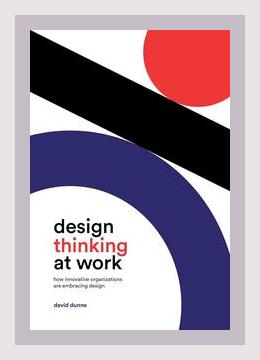Innovation and CreativityDesign Thinking
Title: Design Thinking at Work: How Innovative Organizations Are Embracing Design
Author: David Dunne
Year: 2018
Introduction:
David Dunne’s “Design Thinking at Work: How Innovative Organizations Are Embracing Design” examines how design thinking principles are implemented in various organizations to spur innovation and solve complex problems. Dunne’s analysis is based on real-world case studies and practical examples from numerous industries. This summary delves into the core components of the book, breaking down major points and providing actionable steps based on the advice given.
Understanding Design Thinking
1. Concept and Importance:
– Core Concept: Design thinking is a problem-solving approach that involves understanding user needs, prototyping, testing, and iterating solutions.
– Importance: It emphasizes creativity, collaboration, and user-centricity, fostering innovation and addressing complex challenges.
Example: IDEO, a global design firm, uses empathetic user research to re-envision shopping carts, enhancing user experience.
Action Step: Encourage empathy in your team by conducting user interviews to understand pain points and needs, fostering a user-centered mindset.
2. The Design Thinking Process:
– Stages: The process includes Empathize, Define, Ideate, Prototype, and Test.
– Fluidity: Unlike traditional methods, it’s iterative rather than linear, allowing for continuous refinement.
Example: Stanford’s d.school applies these iterative stages in student projects to promote real-world problem solving.
Action Step: Implement iterative cycles in project development, allowing team members to revisit and refine stages based on feedback.
Case Studies and Applications
3. Government Sector:
– Application: Government agencies using design thinking to innovate and improve public services.
– Example: The Canadian Digital Service (CDS) implemented design thinking to revamp their digital services, focusing on citizen experience.
Action Step: Form cross-disciplinary teams in public service projects to integrate multiple perspectives and enrich problem-solving approaches.
4. Healthcare Industry:
– Challenges: Navigating patient needs, regulatory constraints, and complex systems.
– Example: Kaiser Permanente’s Innovation Consultancy improved patient care by redesigning their nursing-shift changes through design thinking workshops.
Action Step: Identify a specific process (e.g., patient admissions) and use design thinking workshops to brainstorm and prototype improvements.
Key Principles and Practices
5. Empathy:
– Definition: Understanding and sharing the feelings of others to inform design decisions.
– Example: IBM’s design team conducts in-depth user research to gain insights into user needs for their products.
Action Step: Develop empathy maps and personas during product development to ensure a deep understanding of end-users.
6. Collaboration:
– Definition: Encouraging diverse perspectives and teamwork in problem-solving.
– Example: Procter & Gamble uses collaborative design studios to bring together multidisciplinary teams for product innovation.
Action Step: Set up collaborative spaces that facilitate teamwork and use structured brainstorming sessions to leverage collective creativity.
7. Experimentation and Prototyping:
– Importance: Rapidly testing ideas to gather user feedback and iterate.
– Example: Airbnb frequently prototypes new features and tests them with a segment of users before a full rollout.
Action Step: Develop quick, low-fidelity prototypes of new ideas and run pilot tests to gather feedback and refine concepts.
Overcoming Challenges with Design Thinking
8. Cultural Barriers:
– Challenge: Traditional organizational cultures resistant to change.
– Example: A financial institution initially struggled to adopt design thinking due to its risk-averse culture but succeeded after leadership championed the change and demonstrated tangible benefits.
Action Step: Advocate for design thinking at the leadership level, showcasing success stories and potential gains to win broader support.
9. Integrating with Existing Processes:
– Challenge: Blending design thinking with established workflows.
– Example: GE Healthcare integrated design thinking into their product development cycle, maintaining their rigorous safety standards while fostering innovation.
Action Step: Tailor the design thinking process to complement your organization’s existing workflow instead of expecting a complete overhaul.
Strategies for Implementation
10. Building Design Thinking Capabilities:
– Training: Educating employees on design thinking principles.
– Example: SAP’s Design Thinking program includes workshops, online courses, and hands-on projects to build internal competencies.
Action Step: Implement a training program that includes workshops, courses, and real-world projects to build design thinking skills.
11. Leadership and Support:
– Role of Leaders: Leaders must endorse and actively participate in design thinking initiatives.
– Example: CEO Tim Brown of IDEO exemplifies how leadership engagement drives organizational-wide adoption of design thinking.
Action Step: Ensure that leaders are trained in design thinking and actively support and participate in projects.
12. Measuring Impact:
– Metrics: Establishing metrics to assess the impact of design thinking initiatives.
– Example: Capital One tracks qualitative and quantitative metrics to assess the success and ROI of their design-driven projects.
Action Step: Develop metrics to evaluate the impact of design thinking, such as user satisfaction, time-to-market reductions, and return on investment.
Long-term Sustainability and Evolution
13. Continual Learning:
– Evolving Practices: Emphasize continuous learning and adaptation to keep pace with changing needs and technologies.
– Example: Google maintains a culture of constant experimentation and learning through initiatives like Google X.
Action Step: Foster a culture of continual learning by encouraging regular skill development and staying updated with the latest trends in design thinking.
14. Scaling Design Thinking:
– Challenge: Expanding initiatives organization-wide.
– Example: IBM scaled design thinking across its global operations, facilitated by a network of trained design thinking coaches.
Action Step: Develop a scalable framework for design thinking, starting with pilot projects, training internal coaches, and gradually expanding.
Conclusion
David Dunne’s book, “Design Thinking at Work,” underscores the transformative power of design thinking across diverse industries. It emphasizes empathy, collaboration, experimentation, and user-centric approaches as key drivers of innovation. Through varied case studies and practical examples, Dunne provides actionable strategies to incorporate design thinking within organizations. As you embrace these principles, tailor them to your unique challenges and continuously iterate on your processes to foster a culture of innovation and user-centric solutions.
By implementing these actionable steps and drawing inspiration from the real-world examples provided, individuals and organizations can cultivate a robust design thinking mindset and drive meaningful innovation in their respective fields.
